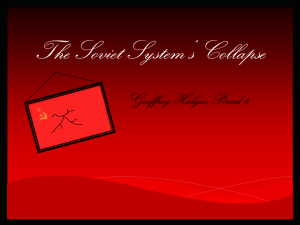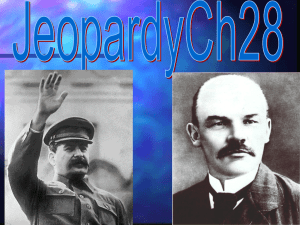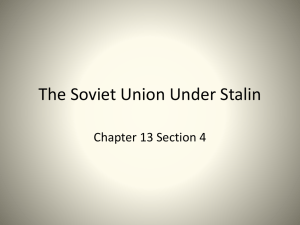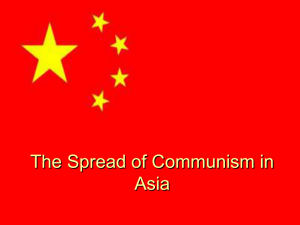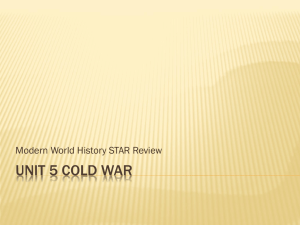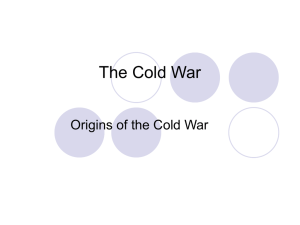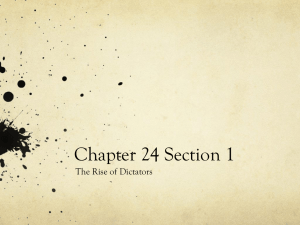Soviet Union: A Totalitarian State
advertisement
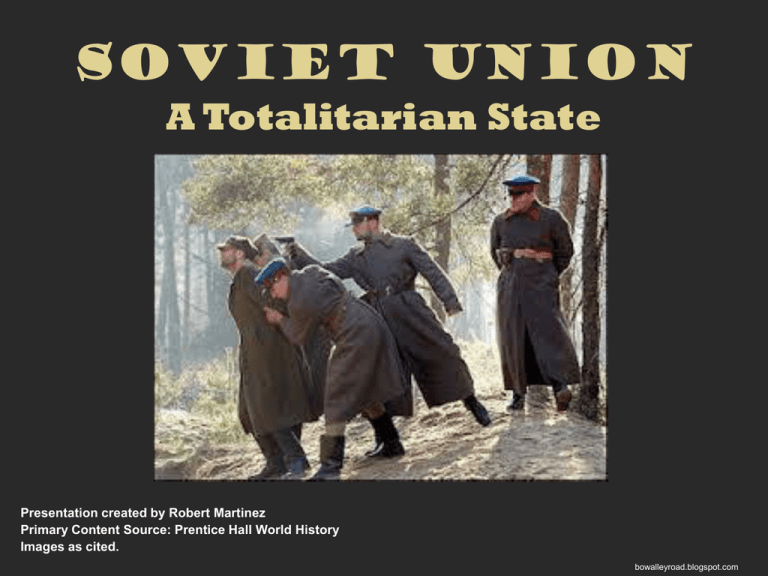
Soviet Union A Totalitarian State Presentation created by Robert Martinez Primary Content Source: Prentice Hall World History Images as cited. bowalleyroad.blogspot.com Karl Marx had predicted that under communism the state would wither away. The opposite occurred under Stalin. He turned the Soviet Union into a totalitarian state. In this form of government, a one-party dictatorship attempts to regulate every aspect of the lives of its citizens. fineartamerica.com To ensure obedience, Stalin’s Communist party used secret police, censorship, violent purges, and terror. Police spies did not hesitate to open private letters or plant listening devices. Nothing appeared in print without official approval. Critics were rounded up and sent to brutal labor camps, where they died. www.oddballdaily.com Using modern technology, the party bombarded the public with relentless propaganda. Radios and loudspeakers blared into factories and villages. In movies, theaters, and schools, citizens heard about communist successes and the evils of capitalism. www.canstockphoto.com Newsreels and newspapers showed bumper harvests and new hydroelectric dams opening up, or proclaimed the misery of workers in the capitalist West. Billboards and posters urged workers to meet or exceed production quotas. lemill.net Stalinist propaganda also revived extreme nationalism. Headlines in the Communist party newspaper, Pravda, linked enemies at home to foreign agents seeking to restore power to the landowners and capitalists. Supporters of Stalin’s aims were often glorified as national heroes. For example, the government put up statues honoring a 14-year-old boy who turned his own father over to the secret police fro associating with kulaks. world.maidanua.org In accordance with the ideas of Marx, atheism, or the belief that there is no god, became an official state policy. Early on, the Communists targeted the Russian Orthodox Church, which had strongly supported the czars. The party seized religious property and converted churches into offices and museums. Many priests and other religious leaders were killed or died in prison camps. zolotoivek.tumblr.com Other religions were persecuted as well. At one show trial, 15 Roman Catholic priests were charged with “counterrevolutionary activities,” such as teaching religion to the young. en.wikipedia.org The state seized Jewish synagogues and banned the use of Hebrew. Islam was also officially discouraged. Muslims living in the Soviet Union generally faced fewer restrictions, partly because the Communists hoped to win support among colonized peoples in the Middle East. www.berdichev.org The Communists replaced religion with their own ideology. Like a religion, communist ideology had its own “sacred” texts – the writings of Marx and Lenin – and its own shrines, such as the tomb of Lenin. Portraits of Stalin replaced religious icons in Russian homes. www.slashfood.com www.abc.net.au The Communists transformed Russian life. They destroyed the old social order of landowning nobles at the top and serfs at the bottom. But instead of creating a society of equals, as they promised, they created a society where a few elite groups emerged as a new ruling class. At the head of society were members of the Communist party. Only a small fraction of Soviet citizens were allowed to join the party. Many who did so were motivated by a desire to get ahead, rather than a belief in communist ideology. www.libertariantoday.com The Soviet elite also included industrial managers, military leaders, scientists, and some artists and writers. The elite enjoyed benefits denied to most people. They had the best apartments in the cities and vacation homes in the country. They could shop at special stores for scarce consumer goods. www.kyivpost.com Although excluded from party membership, most people did enjoy benefits unknown before the revolution. Free education was offered to all. The state also provided free medical care, day care for children, inexpensive housing, and public recreation. englishrussia.com While these benefits were real, the standard of living remained low. As elsewhere, industrial growth led millions of people to migrate to cities. Although the state built massive apartment complexes, housing was scarce. Entire families might be packed into a single room. Bread was plentiful, but meat, fresh fruit, and other foods were in short supply. commons.wikimedia.org After the Russian Revolution, the Communists built schools everywhere and required all children to attend. The state supported technical schools and universities as well. Schools served many important goals. Educated workers were needed to build a modern industrial state. In addition to basic skills, schools taught communist values, such as atheism, the glory of collective farming, and love of Stalin. www.scounselor.com The Communist party also set up programs for students outside school. These programs included sports, cultural activities, and political classes to train teenagers for party membership. Sometimes, young Communists would be sent to help harvest crops or to participate in huge parades. letsgodu.blogspot.com Under the Communists, women won equality under the law. They gained access to education and a wide range of jobs. By the 1930s, many Soviet women were working in medicine, engineering, or the sciences. By their labor, women contributed to Soviet economic growth. They worked in factories, in construction, and on collectives. Within the family, their wages were needed because men earned low salaries. The government provided day nurseries for children. www.marxists.org The Bolshevik Revolution at first meant greater freedom for Russian artists and writers. “Art must serve politics,” Lenin had insisted, but he generally did not interfere with artistic freedom. Artists welcomed the chance to experiment with ideas and forms. counterlightsrantsandblather1.blogspot.com Under Stalin, the heavy hand of state control gripped the arts. Stalin forced artists and writers to conform to a style called socialist realism. Its goal was to boost socialism by showing Soviet life in a positive light. Their overall message had to promote hope in the communist future. Popular themes for socialist-realist artists were peasants, workers, heroes of the revolution, and – of course – Stalin. uttaps.wordpress.com Government controlled what books were published, what music was heard, and which works of art were displayed. Artists who ignored Communist guidelines could not get materials, work space, or jobs. Under Stalin’s totalitarian policies, writers, artists, and composers faced government persecution. www.realthinktank.com Despite restrictions, some Soviet writers produced magnificent works. And Quiet Flows the Don, by Mikhail Sholokhov, passed the censor. The novel tells the story of a man who spends years fighting in World War I, the Russian Revolution, and the civil war. Sholokhov later became one of the few Soviet writers to win the Nobel Prize for Literature. en.wikipedia.org www.terry-posters.com By the time Stalin died in 1953, the Soviet Union had become a military superpower and a world leader in heavy industry. Yet Stalin’s efforts exacted a brutal toll. The Soviet people were dominated by a totalitarian system based on terror. Most people in the Soviet Union lived meager lives compared with people in the West. polishgreatness.blogspot.com The Soviet Union was not the only totalitarian state to emerge in the decades after World War I. In the 1920s and 1930s, dictators arose in Italy and Germany. They, too, created oneparty states and cults of personality to impose dictatorial rule on their people. exleftist.com


